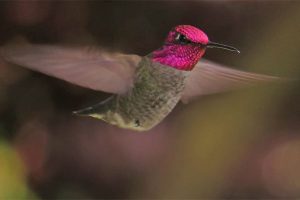 Download a pdf of this information.
Download a pdf of this information.
Many of us want to attract birds, butterflies, bats, and other wild creatures to our gardens. It is actually very easy to do that! All you need to do is provide your guests four important things: 1) Food, 2) Water 3) Shelter 4) Space. In this handout, we list many woody and perennial landscape plants that provide food for a variety of birds, butterflies, and beneficial insects.
Shelter Plants for Birds
One of the best way to draw birds to your garden is to provide nesting areas and cover by planting a mixture of plants. Evergreen trees such as conifers provide year round shelter for birds & cones with edible seeds. Many conifers also host insects that are food for birds. Combining deciduous and evergreen trees and shrubs so that there are shelter plants of various heights will attract a greater diversity of birds to your garden. Some birds prefer taller, more open trees as nesting sites; others want denser, lower cover. Adding nest boxes, feeders, and a water source will also make the garden more attractive to the birds.
Trees, Vines, & Shrubs for Berries and Seeds
Many songbirds are berry lovers, and providing berries will draw them to your garden. Try to make sure that you have berries over a long period of time, and include some plants whose fruit persists into winter. The plants below are favorites of birds in our climate.
-
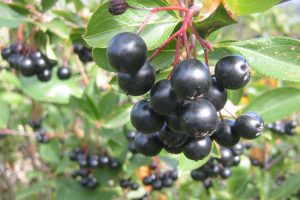
Aronia berries
Amelanchier species (Some native) Deciduous shrubs with white spring flowers, edible berries in summer, and good fall foliage.
- Arbutus sp. Strawberry Tree, Madrone (Some native). Evergreen shrubs and trees with late summer or fall fruit and berries very attractive to birds. Need well drained soil.
- Aronia meloncarpa Deciduous shrub to 8′, good fall color, fruits late summer. Tolerates wet soils.
- Berberis species Deciduous & evergreen shrubs 2′-6′, fruit late summer, deer resistant, tolerant of drought once established.
- Callicarpa sp. Deciduous shrubs, to 8′, grown for their purple or lavender fruit. The bright winter berries are attractive to birds.
- Cornus kousa, Cornus rutgerensis Chinese and hybrid dogwood. Deciduous flowering trees to 20′, fruit in autumn
- Cornus mas Cornelian Cherry. Deciduous flowering large shrub or small tree to 15′-20′, very early spring flowers of bright yellow, red, cherry like fruit in autumn
- Cornus stolonifera (sericea) (Some native) Red osier Deciduous shrubs to 6′-8′, berry. like fruit ripens in late summer, persists as fall and winter food for birds.
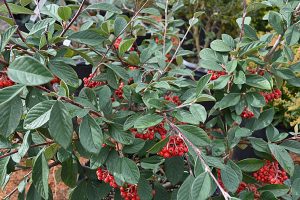
Cotoneaster parneyi
- Cotoneaster species Deciduous & evergreen shrubs, trees & groundcovers, berries in fall & winter.
- Gaultheria species (Some native) Salal, Wintergreen. Evergreen groundcovers, berries summer into
- Mahonia species (Some native) Oregon Grape & Evergreen shrubs with flowers providing nectar in winter and early spring, berries late summer and fall. Many sizes available, the PNW native species are drought tolerant.
- Malus species & hybrids Flowering Deciduous shrubs or small trees to 15′, fruit through winter. Choose scab resistant varieties.
- Morella (Myrica) californica (Coastal native) Pacific Wax Myrtle. Large evergreen shrub with small fruit that persists in winter.
- Physocarpus sp.(Some native) Deciduous shrubs, to 9′-10′. Arching habit, late spring flowers lead to seed heads attractive to seed eaters including finches. Tolerant of wet soil.
- Ribes species (Some native) Flowering currants. Deciduous shrubs to 10′, nectar in spring, berries late
- Sambucus species (Some native) Deciduous shrubs to 10′, berries late summer.
- Symphoricarpos albus (native) Deciduous native shrub with white berries. These berries are not eaten by birds until late winter, when food supplies for them are scarce.
- Vaccinium species (Some native) Blueberries, Lingonberries, Huckleberries. Many varieties of deciduous and evergreen shrubs, from low groundcovers to 8′, all bear fruit through summer & early fall.
- Viburnum Viburnum. Many of these deciduous and evergreen shrubs follow their showy flowers with berries.
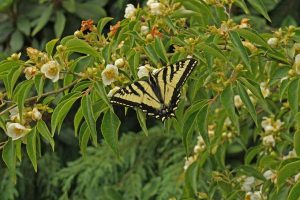 Trees, Vines, Shrubs & Perennials for Nectar for Butterflies, Hummingbirds, & Beneficial Insects
Trees, Vines, Shrubs & Perennials for Nectar for Butterflies, Hummingbirds, & Beneficial Insects
Butterflies, bees and hummingbirds all rely on flower nectar for food. Having flowers blooming most of the year will ensure that they don’t go hungry. Many of these plants are also attractive to beneficial insects that help keep pests in check. These plants are especially attractive to butterflies and hummingbirds, and will also draw bees and other beneficial insects to your garden.
- Abelia sp. Glossy Abelia. Arching shrubs, evergreen or semi-evergreen, with late summer flowers, especially attractive to
- Calluna vulgaris Many cultivars of low, evergreen shrubs, some with colorful foliage, blooming in late summer. Very attractive to bees and butterflies.
- Ceanothus sp. (Some native) native)California Wild Lilac. Evergreen shrubs with blue or white flowers late spring. Very attractive to both bees and butterflies.
- Crocosmia x Crocosmia or Montbretia. Iris relatives with late summer flowers of scarlet to orange. Loved by hummingbirds.
- Escallonia hybrids Evergreen shrubs with summer flowers in shades of white to pink. Salt spray tolerant. Check hardiness for your area.
- Fuchsia magellanica Hardy Fuchsia. Deciduous perennials or shrubs with small summer flowers of pink to red, loved by hummingbirds.
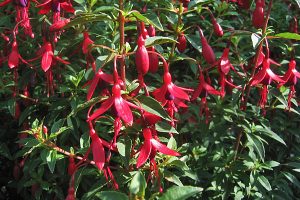
Hardy fuchsia
- Grevillea victorae Silk Oak. Evergreen shrub to 8′ high and wide, orange flowers bloom winter in spring, enjoyed by hummingbirds.
- Hamamelis species Witch Deciduous shrubs to 15′, flowers late winter, providing nectar when little else is blooming.
- Hebe species Shrubby Veronica or Small evergreen shrubs with summer flowers that are very attractive to butterflies. Check hardiness for your area.
- Holodiscus discolor (Native) Ocean Spray. Deciduous shrub to 12′, flowers in June, attractive to both bees and butterflies.
- Lavendula sp. Low evergreen shrubs with spikes of fragrant flowers, attracting bees and butterflies.
- Lonicera species (Some native) Deciduous shrubs & vines, fragrant flowers spring & summer, often followed by berries for songbirds.
- Mahonia species (Some native)Oregon Grape and Mahonia. Evergreen shrubs, winter or late spring flowering; the flowers are very attractive to hummingbirds and native bees.
- Philadephus sp. (Some native) Mock Orange. Deciduous shrubs with fragrant June flowers, very attractive to butterflies.
- Pieris japonica Evergreen shrubs 3′-8′, flowers early spring are very attractive to bees.
- Phygelius sp. Cape Fuchsia. Creeping deciduous to shrubby perennials with a long summer bloom of trumpet like flowers, favored by hummingbirds and bumblebees.
- Ribes sanguineum (Native)Red Flowering Currant. Deciduous shrub to 8′, late winter flowers loved by hummingbirds, followed by fruit in late summer for songbirds.
- Salvia officianalis Culinary Sage. Evergreen shrub with spikes of blue flowers in summer; very attractive to both bees and butterflies
- Syringa vulgaris Deciduous shrubs to 12′, spring flowers attracting bees and butterflies.
Perennials for Butterflies
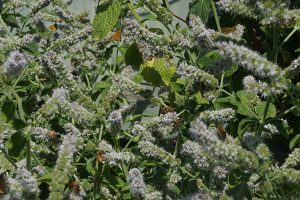
Bees and skipper butterflies on mint flowers
Many herbaceous perennials are favorite nectar plant of butterflies. Almost all of them are full sun lovers, and do well in the warm to hot sites favored by butterflies.
- Achillea sp. (Some native) Ferny evergreen foliage topped by flat flower clusters, many colors.
- Aster sp. (Some native) Late summer, daisy like flowers.
- Coreopsis sp. Daisy like flowers mostly in yellow to orange tones.
- Echinacea sp. Daisy like flowers in many colors, need well-drained soil.
- Mentha sp. Mints. Aromatic herbaceous perennials, creeping habit. Late summer flowers are very attractive to bees and butterflies. Some varieties can become invasive.
-
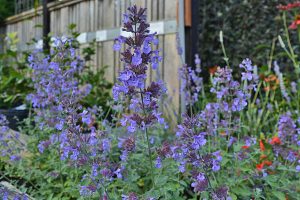
Nepeta x
Monarda sp. Bee Balm. Mint relatives, spread rapidly in moist soil. Choose mildew resistant cultivars.
- Nepeta sp. Gray foliaged perennials with spikes of blue flowers.
- Phlox sp. Groundcover to tall perennials with spring to summer flowers.
- Rudbeckia sp. Black Eyed Susan. Bright yellow, daisy like
- Sedum sp. (Some native) Succulent perennials in many forms, most like sunny hot spots.
Other Butterfly Garden Elements
To truly attract and keep butterflies coming to your garden, you need to provide them a favorable habitat. Butterflies are attracted to sunny, open gardens where they can warm their bodies. They cannot drink from open water, so provide a container of wet sand, sunk to soil level, to provide a drinking spot for them. Besides providing nectar plants for adult butterflies, you must also provide host plants for their larvae to feed on. We are providing a list of plants that butterflies favor as host plants. Many favored host plants are perennials rather than trees and shrubs, but in our area a few groups of plants are common host plants. Expect these plants to be munched!
- Betula sp. (Some native) Large deciduous trees, favored host of several species of butterflies.
- Carrot Family (Some native) Most members of this family, including dill, fennel, yarrow, and
- Prunus sp. Cherry, Bittercherry, (Some native) Chokecherry. Deciduous trees, favored host plants, also attractive fruit for birds.
- Populus sp. (Some native) Cottonwood, Poplar, Aspen. Large deciduous trees, all favored as host plants.26
- Salix sp. (Some native) Willows are one of the favored host plants in our climate.
- Wisteria sp. Large deciduous vines, favored host plants.
Letting some of the fringe of your garden go to wild plants can also provide hosts for butterfly larvae. Burdock, nettles, Queen Anne’s Lace and white clover are all popular hosts. Avoid using pesticides near plants that might be hosting butterfly larvae. Learn to recognize chewed leaves as feeding potential butterflies!
